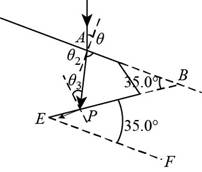
Concept explainers
(a)
The critical angle for total internal reflection for light in the diamond incident on the interface between the diamond and outside air.
(a)
Answer to Problem 28P
Explanation of Solution
Given info: The condition for light ray travelling between air and a diamond is shown below.

Figure (I)
From Snell’s law of refraction to air-diamond interface to find the critical angle is,
Here,
The value of
Substitute 1 for
Thus, the critical angle of refraction at air-diamond interface is
Conclusion:
Therefore, the critical angle of refraction at air-diamond interface is
(b)
To show: The light travelling towards point
(b)
Answer to Problem 28P
Explanation of Solution
Given info: The condition for light ray travelling between air and a diamond is shown in figure (I).
The critical angle for total internal reflection for light in the diamond incident on the interface between the diamond and outside air is
Conclusion:
Therefore, the angle of incidence is more than the critical angle all light is reflected from point P.
(c)
The critical angle for total internal reflection for light in the diamond when the diamond is immersed in the water.
(c)
Answer to Problem 28P
Explanation of Solution
Given info: The condition for light ray travelling between air and a diamond is shown in figure (I).
From Snell’s law of refraction to water-diamond interface to find the critical angle is,
Here,
The value of
Substitute 1 for
Thus, the critical angle of incidence at water-diamond interface is
Conclusion:
Therefore, the critical angle of incidence at water-diamond interface is
(d)
The ray incident at point P
(d)
Answer to Problem 28P
Explanation of Solution
Given info: The condition for light ray travelling between air and a diamond is shown in figure (I).
The critical angle for total internal reflection for light in the diamond incident on the interface between the diamond and water is
Thus, the light undergoes total internal reflection at
Conclusion:
Therefore, the light undergoes total internal reflection at
(e)
The direction in which the diamond is rotated such that the light at a point P
(e)
Answer to Problem 28P
Explanation of Solution
Given info: The condition for light ray travelling between air and a diamond is shown in figure (I).
The critical angle for total internal reflection for light in the diamond incident on the interface between the diamond and water is
The light will exit from the diamond only when the incident angle is less than the critical angle. So, to reduce the angle of incidence the diamond should be rotated in clockwise direction on the axis perpendicular to the plane of paper.
Thus, the light will exit at point
Conclusion:
Therefore, the light will exit at point
(f)
The angle of rotation at which the light first exit the diamond at point P
(f)
Answer to Problem 28P
Explanation of Solution
Given info: The condition for light ray travelling between air and a diamond is shown in figure (I).
Let the angle is rotated clockwise by
Apply Snell’s law at the water-diamond interface.
The condition of the situation is shown below.

Figure (II)
The angle at the vertex
The requirement is that the angle of incidence
Apply Snell’s law and find angle
Substitute
Thus, the diamond is rotated by
Conclusion:
Therefore, the diamond is rotated by
Want to see more full solutions like this?
Chapter 34 Solutions
Webassign Printed Access Card For Serway/jewett's Physics For Scientists And Engineers, 10th, Single-term
- Another worker is performing a task with an RWL of only 9 kg and is lifting 18 kg, giving him an LI of 2.0 (high risk). Questions:What is the primary issue according to NIOSH?Name two factors of the RWL that could be improved to reduce risk.If the horizontal distance is reduced from 50 cm to 30 cm, how does the HM change and what effect would it have?arrow_forwardTwo complex values are z1=8 + 8i, z2=15 + 7 i. z1∗ and z2∗ are the complex conjugate values. Any complex value can be expessed in the form of a+bi=reiθ. Find r and θ for z1z2∗. Find r and θ for z1/z2∗? Find r and θ for (z1−z2)∗/z1+z2∗. Find r and θ for (z1−z2)∗/z1z2∗ Please explain all steps, Thank youarrow_forwardAn ac series circuit consists of a voltage source of frequency 60 Hz and voltage amplitude V, a 505-Ω resistor, and a capacitor of capacitance 7.2 μF. What must be the source voltage amplitude V for the average electrical power consumed in the resistor to be 236 W? There is no inductance in the circuit.arrow_forward
- An L−R−C series circuit has R= 280 Ω . At the frequency of the source, the inductor has reactance XLL= 905 Ω and the capacitor has reactance XC= 485 Ω . The amplitude of the voltage across the inductor is 445 V . What is the amplitude of the voltage across the resistor and the capacitor? What is the voltage amplitude of the source? What is the rate at which the source is delivering electrical energy to the circuit?arrow_forwardA 0.185 H inductor is connected in series with a 98.5 Ω resistor and an ac source. The voltage across the inductor is vL=−(12.5V)sin[(476rad/s)t]vL. Derive an expression for the voltage vR across the resistor. Express your answer in terms of the variables L, R, VL (amplitude of the voltage across the inductor), ω, and t. What is vR at 2.13 ms ? Please explain all stepsarrow_forwardA worker lifts a box under the following conditions:Horizontal distance (H): 30 cmInitial height (V): 60 cmVertical travel (D): 50 cmTorso rotation (A): 30°Frequency: 3 times/minute for 1 hourGrip: Good Question:What is the RWL for this task?What does this value mean in terms of occupational safety?arrow_forward
- Can someone helparrow_forwardCan someone help mearrow_forward3. Four identical small masses are connected in a flat perfect square. Rank the relative rotational inertias (IA, IB, IC) about the three axes of rotation shown. Axes A and B are in the plane of the square, and axis C is perpendicular to the plane, through mass m1. ΙΑ IB m2 m1 m3 Ic m4 (a) IAarrow_forwardConsider the circuit shown in the figure below. (Assume L = 5.20 m and R2 = 440 Ω.) (a) When the switch is in position a, for what value of R1 will the circuit have a time constant of 15.4 µs? (b) What is the current in the inductor at the instant the switch is thrown to position b?arrow_forwardCan someone helparrow_forwardCan someone help mearrow_forwardarrow_back_iosSEE MORE QUESTIONSarrow_forward_ios
 Physics for Scientists and Engineers: Foundations...PhysicsISBN:9781133939146Author:Katz, Debora M.Publisher:Cengage Learning
Physics for Scientists and Engineers: Foundations...PhysicsISBN:9781133939146Author:Katz, Debora M.Publisher:Cengage Learning Physics for Scientists and EngineersPhysicsISBN:9781337553278Author:Raymond A. Serway, John W. JewettPublisher:Cengage Learning
Physics for Scientists and EngineersPhysicsISBN:9781337553278Author:Raymond A. Serway, John W. JewettPublisher:Cengage Learning Physics for Scientists and Engineers with Modern ...PhysicsISBN:9781337553292Author:Raymond A. Serway, John W. JewettPublisher:Cengage Learning
Physics for Scientists and Engineers with Modern ...PhysicsISBN:9781337553292Author:Raymond A. Serway, John W. JewettPublisher:Cengage Learning Principles of Physics: A Calculus-Based TextPhysicsISBN:9781133104261Author:Raymond A. Serway, John W. JewettPublisher:Cengage Learning
Principles of Physics: A Calculus-Based TextPhysicsISBN:9781133104261Author:Raymond A. Serway, John W. JewettPublisher:Cengage Learning College PhysicsPhysicsISBN:9781305952300Author:Raymond A. Serway, Chris VuillePublisher:Cengage Learning
College PhysicsPhysicsISBN:9781305952300Author:Raymond A. Serway, Chris VuillePublisher:Cengage Learning College PhysicsPhysicsISBN:9781285737027Author:Raymond A. Serway, Chris VuillePublisher:Cengage Learning
College PhysicsPhysicsISBN:9781285737027Author:Raymond A. Serway, Chris VuillePublisher:Cengage Learning





